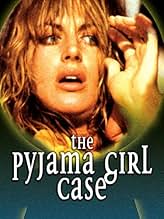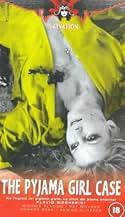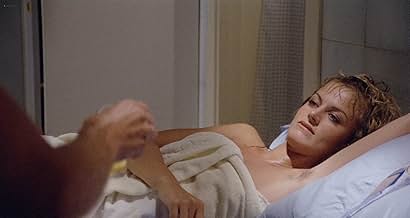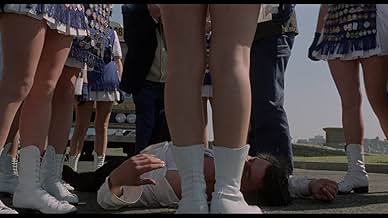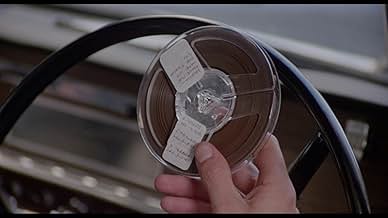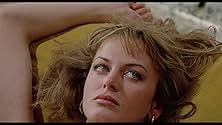AVALIAÇÃO DA IMDb
6,0/10
1,5 mil
SUA AVALIAÇÃO
Adicionar um enredo no seu idiomaIn Australia, a retired police inspector is called to duty to solve the murder case of a young woman whose partially-burned body has been found on the beach.In Australia, a retired police inspector is called to duty to solve the murder case of a young woman whose partially-burned body has been found on the beach.In Australia, a retired police inspector is called to duty to solve the murder case of a young woman whose partially-burned body has been found on the beach.
- Direção
- Roteiristas
- Artistas
Antonio Ferrandis
- Nottingham
- (as Antonio Ferrandiz)
Luis Barboo
- Viewer of Body in Glass Case
- (não creditado)
Tito García
- Fat Man in Final Foursome
- (não creditado)
Avaliações em destaque
A little girl in Australia finds a dead woman wearing yellow pajamas on a beach, whose head has been badly disfigured or burnt. The police have no idea who she is. Scenes alternate between the police investigation storyline, and scenes from the life of a woman who has a number of different men in her life. How the latter scenes fit in doesn't become clear (or didn't for me) until fairly far into the movie. In fact, I think the other user misunderstood who she was.
This is a fair giallo, but something that really hurt it for me was that there were so many characters who weren't really well identified. From scene to scene I often wasn't sure if I was meeting someone new, or someone from a previous scene.
It isn't without some interest. One memorable scene was when the police put the body into a glass case and put it on public display in an attempt to find someone who could identify her!
Perhaps it was just a flaw in my copy, but it seemed like some short scenes or shots were tinted different colors. There are other scenes where there are clearly intentional changes in colored lights, as when there is an advertising sign just outside a window.
This is a fair giallo, but something that really hurt it for me was that there were so many characters who weren't really well identified. From scene to scene I often wasn't sure if I was meeting someone new, or someone from a previous scene.
It isn't without some interest. One memorable scene was when the police put the body into a glass case and put it on public display in an attempt to find someone who could identify her!
Perhaps it was just a flaw in my copy, but it seemed like some short scenes or shots were tinted different colors. There are other scenes where there are clearly intentional changes in colored lights, as when there is an advertising sign just outside a window.
A detective searches for the identity and killer of a young woman found dead on the beach, wearing only a pair of yellow pajamas; meanwhile, a friend of the dead woman sets off on the road to avoid being the next victim. That's not all there is, but the central idea behind this film's construction is so brilliant I can't say any more. The end is such a surprise that you'll either be blown away or feel ripped off. It plays with story construction in a way I've never seen done before, one that's begging to be copied by some high-profile indie here in the US. Film school buffs will dig it and find a lot to argue about, others might be confused or annoyed. Ray Milland is good but kind of decrepit-looking, here in the evening of his career; the chief culprits in this film are the pop songs that they repeat endlessly (though catchy). I'd love to see reactions to this one; I recommend it highly.
10django-1
Those expecting a sleazy, gory late entry in the "giallo" cycle of Italian cinema might be let down at THE PYJAMA GIRL CASE, but the film is actually a superb murder mystery, a fascinating character study, a police procedural, and a visually striking experience. Perhaps it's best to say that it was "inspired by a true story," since much liberty is taken with the original Australian case on which the film is based (and the Blue Underground DVD has as an extra an interview with investigative Australian author Richard Evans, who wrote a book about the real case from the 1930's). Ray Milland stars as a retired detective who spends time most of his time in his greenhouse (is this an allusion to the Columbo episode where Milland was into gardening?) but is brought out of retirement by a baffling case where an unknown corpse is found charred and decayed in an abandoned car on a beach. The police must first find who the woman is before finding who killed her. All the while as this story is being told we are following a second plot which I won't divulge here. At about the mid-point it seems as though the film might be nearly over, but it takes another turn and the chronologies of the stories become clear. As a regular watcher and reader of murder mysteries, the red herring characters were clear to me, the identity of the victim was no surprise, and the solution to the crime was not as much of a surprise as other IMDb reviews seem to think. However, I was riveted the way I am in a good Columbo episode thinking about the HOW and the WHY of the crime, and the clever way in which the various threads are tied together. Milland is, as always, superb, bringing many interesting quirks to the character of Thompson the retired detective. Michele Placido is impressive as the Italian immigrant waiter who is a major player in the parallel story, and Mel Ferrer is his usual suave self as a Professor who is having an affair with Placido's wife, who is played by the lovely Dalila Di Lazzaro. Fortunately, Milland and Ferrer provide their own voices. Howard Ross is also memorable as a vain and brutal German who is also having an affair with Dalila. While Riz Ortalani's music is largely the thumping electric euro-funk one expects in a 1977 film, it's much more subtle than, say, a soundtrack by Goblin, and two songs by Amanda Lear (my wife asked me "is that Nico?") are haunting and perfect, although many will find themselves initially put off by her singing. I don't think I can get the main song of hers out of my head. I had always considered buying a pan-and-scan VHS of this, but I'm glad I waited for the new and beautiful widescreen DVD. The Australian locations for the film as surprising and shot in an unexpected way that is fresh and makes the background an important character. I've been waiting to see this for two decades, and while it wasn't exactly what I was expecting, I was completely satisfied by it and watched it twice the day I bought it. Mystery fans and those into 70's Italian genre films should not miss it. However, don't expect the level of sex and violence you're usually provided in such films.
Often referred to as a giallo, The Pyjama Girl Case (or The Girl in the Yellow Pajamas) is one of the more unique entries into the sub-genre. Frankly, it's not really much of a giallo in my eyes. I look at it as more of a dramatic murder mystery with some underlying splashes of the yellow paint.
In Sydney, a young girl discovers the charred remains of a woman in an old car on the beach. The woman's face is too badly burned for the police to make a proper identification. The case is given to an inspector by the name of Ramsey, though retired Inspector Thompson insists on getting involved as well much to Ramsey's dismay. While we watch their investigation unfold, we are also treated to an alternate story involving a sexually troubled young woman who has gotten herself involved with three different men. What's the connection? Ray Milland is solid as the retired Thompson, and he delivers a few laughs to boot. He has a distaste for the methods that police have began using since his time on the force, and it's quite entertaining to watch his sense of glee whenever he's crowding Ramsey's space. Ramsey is a pretty unlikable guy too. He refuses to listen to Thompson's logical reasoning, and he tries his best to find a scapegoat as quickly as he can. Caring more about getting credit and going on a nice vacation as soon as possible, Ramsey is behind Thompson every step of the way.
On the alternate end of the spectrum, Dalila Di Lazzaro successfully captures the very troubled and torn nature of her character, Glenda. She spends her time between a wealthy doctor (Mel Ferrer) and a German factory employee (Howard Ross), both of whom she uses for meaningless sex. Through Roy, the German, she meets Antonio, a Polish waiter with a seemingly soft and sensitive nature. They fall for each other and marry, but the marriage is a very troubled one as Glenda, starved for both intimacy and an emotional connection, becomes very bored with the shy natured Antonio. This in turn sets off his jealous tendencies. As Antonio, I think Michele Placido gives what is perhaps the film's best performance. He's just as troubled as his wife, and his emotional outbursts seem genuine and heartfelt.
The film's unique narrative is constructed in an effective manner as we bounce back and forth not only between stories, but in time as well. Director Mogherini also throws in some wonderful pieces of misdirection throughout the alternating story lines. Carlo Carlini's cinematography is splendid. Sydney is a lovely city, and Carlini milks it for all it's worth, delivering some striking shots and images. Mogherini's film is further complimented by some rather arty directorial flourishes. One of my favorite sequences has tons of people in trance-like states shuffling around a tank containing the woman's body, the police hoping someone will be able to identify her. The scene plays to Riz Ortolani's beautifully haunting score, and has a very surreal, detached feel to it. It's a masterfully crafted little sequence.
Overall, while a stylish film, The Pyjama Girl Case is mainly about the characters. It's a very character driven story with a real emotional punch to it, something I wasn't expecting when I first gave it a go. I have zero reservations about recommending this to fans of gialli and Eurohorror in general. Just don't go in expecting your typical giallo.
In Sydney, a young girl discovers the charred remains of a woman in an old car on the beach. The woman's face is too badly burned for the police to make a proper identification. The case is given to an inspector by the name of Ramsey, though retired Inspector Thompson insists on getting involved as well much to Ramsey's dismay. While we watch their investigation unfold, we are also treated to an alternate story involving a sexually troubled young woman who has gotten herself involved with three different men. What's the connection? Ray Milland is solid as the retired Thompson, and he delivers a few laughs to boot. He has a distaste for the methods that police have began using since his time on the force, and it's quite entertaining to watch his sense of glee whenever he's crowding Ramsey's space. Ramsey is a pretty unlikable guy too. He refuses to listen to Thompson's logical reasoning, and he tries his best to find a scapegoat as quickly as he can. Caring more about getting credit and going on a nice vacation as soon as possible, Ramsey is behind Thompson every step of the way.
On the alternate end of the spectrum, Dalila Di Lazzaro successfully captures the very troubled and torn nature of her character, Glenda. She spends her time between a wealthy doctor (Mel Ferrer) and a German factory employee (Howard Ross), both of whom she uses for meaningless sex. Through Roy, the German, she meets Antonio, a Polish waiter with a seemingly soft and sensitive nature. They fall for each other and marry, but the marriage is a very troubled one as Glenda, starved for both intimacy and an emotional connection, becomes very bored with the shy natured Antonio. This in turn sets off his jealous tendencies. As Antonio, I think Michele Placido gives what is perhaps the film's best performance. He's just as troubled as his wife, and his emotional outbursts seem genuine and heartfelt.
The film's unique narrative is constructed in an effective manner as we bounce back and forth not only between stories, but in time as well. Director Mogherini also throws in some wonderful pieces of misdirection throughout the alternating story lines. Carlo Carlini's cinematography is splendid. Sydney is a lovely city, and Carlini milks it for all it's worth, delivering some striking shots and images. Mogherini's film is further complimented by some rather arty directorial flourishes. One of my favorite sequences has tons of people in trance-like states shuffling around a tank containing the woman's body, the police hoping someone will be able to identify her. The scene plays to Riz Ortolani's beautifully haunting score, and has a very surreal, detached feel to it. It's a masterfully crafted little sequence.
Overall, while a stylish film, The Pyjama Girl Case is mainly about the characters. It's a very character driven story with a real emotional punch to it, something I wasn't expecting when I first gave it a go. I have zero reservations about recommending this to fans of gialli and Eurohorror in general. Just don't go in expecting your typical giallo.
Ray Milland had a long career (1929-1985) and many roles, including his Oscar as Best Actor in Billy Wilder's Lost Weekend. He managed a couple of Italian films in the 70s, including this one.
It is not a typical giallo, as the body count is very low. However, it does have a certain charm as a police procedural as they try to discover who killed the girl in the yellow pyjamas.
Seeing Dalila Di Lazzaro certainly makes the film worthwhile, and you do see all of her as she romps with men and women (Vanessa Vitale, who was not bad herself.).
Red herrings and surprises abound in a film that was shot in Sydney, and really looked good there. In fact, it was based upon a true story in Austrailia in the 30s.
Good acting by Lazarro and Michele Placido, as well as a fine performance by Milland.
It is not a typical giallo, as the body count is very low. However, it does have a certain charm as a police procedural as they try to discover who killed the girl in the yellow pyjamas.
Seeing Dalila Di Lazzaro certainly makes the film worthwhile, and you do see all of her as she romps with men and women (Vanessa Vitale, who was not bad herself.).
Red herrings and surprises abound in a film that was shot in Sydney, and really looked good there. In fact, it was based upon a true story in Austrailia in the 30s.
Good acting by Lazarro and Michele Placido, as well as a fine performance by Milland.
Você sabia?
- CuriosidadesThis film was inspired by a sensational real-life murder case that happened in Australia in 1934.
- Citações
Amanda Lear: The man that you really wanted, and who got away. And then came another, didn't know the way to love her. And you want another, cause you know it's now or never, because you're a woman.
- ConexõesFeatured in The Pyjama Girl Mystery: A True Story of Murder, Obsession and Lies (2006)
Principais escolhas
Faça login para avaliar e ver a lista de recomendações personalizadas
- How long is The Pyjama Girl Case?Fornecido pela Alexa
Detalhes
- Data de lançamento
- Países de origem
- Idioma
- Também conhecido como
- The Pyjama Girl Case
- Locações de filme
- Empresas de produção
- Consulte mais créditos da empresa na IMDbPro
Contribua para esta página
Sugerir uma alteração ou adicionar conteúdo ausente

Principal brecha
By what name was A moça do Pijama Amarelo (1978) officially released in India in English?
Responda

